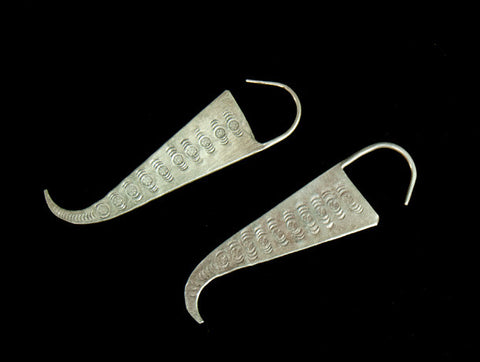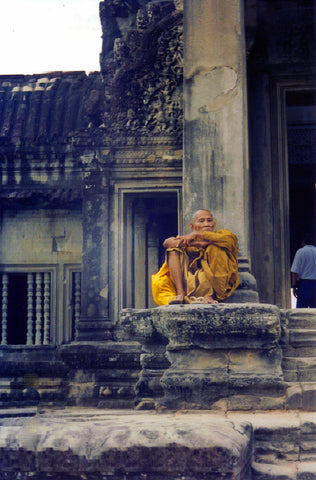Your Cart is Empty
Free Shipping for orders over $49 in Australia, $199 IN NEW ZEALAND/USA/CANADA AND $249 REST OF THE WORLD
Free Shipping for orders over $49 in Australia, $199 IN NEW ZEALAND/USA/CANADA AND $249 REST OF THE WORLD
Add description, images, menus and links to your mega menu
A column with no settings can be used as a spacer
Link to your collections, sales and even external links
Add up to five columns
Add description, images, menus and links to your mega menu
A column with no settings can be used as a spacer
Link to your collections, sales and even external links
Add up to five columns
Spirit Locks: Spiritual Beliefs of the Hmong
by Linda Heaphy April 28, 2017
Spirit locks are metal padlock or hook shaped pendants worn around the neck or on the body as personal protective amulets. They function to 'lock' the soul of a person into his or her body in the case of illness, accident or spiritual malaise. Spirit locks are primarily worn by the Hmong and Akha hilltribe people of Thailand, Burma and Laos.
The Hmong are spirit worshippers, otherwise known as animists, who believe that every animate and inanimate object has one or more souls, inhabiting spirits or phi, some of which are inherently good and some which are bad. The spirits of deceased ancestors are also thought to influence the welfare and health of the living. All these spirits need to be placated with offerings and prayers to ward off sickness and catastrophe. Hmong shamans play a central role in village life and decision-making and every household has an altar where spirits are supplicated and protection for the household is sought.
Human beings in particular are believed to be inhabited by several souls. These can potentially fall into disharmony and might even leave the body, for example if a person were to be badly frightened or find themselves under great physical or mental stress. External manipulations might also cause a foreign spirit to enter a person's body, causing disharmony and malaise. In an animist culture for which until relatively recently opium was the only available palliative drug, these beliefs were used to explain, rationalise and attempt to control sickness, disease and mental illness such as depression and schizophrenia.
To redress these imbalances and aid in curing ill patients, community elders led by the shaman performs a Soul Calling ceremony, casting out unwanted spirits or luring good spirits back into the patient's body as required. The wearer's souls are then protected from escaping the body and from further manipulations by the placement of a spirit lock amulet. The size of the amulet traditionally indicates the seriousness of the illness or the problem to be cured.
Spirit locks have a secondary, preventative amuletic function within Hmong and Akha culture. It is considered good luck to give newborn babies spirit locks to protect them from evil spirits and these are worn throughout their entire lives, often on the back. It is still common in Thailand to see children wearing three of four spirit locks at a time. Spirit locks are usually fastened by chains to neck rings, which may be solid or hollow and worn either singly or in sets of up to 6 tiers.
Silver jewellery is valued highly by the Hmong people and spirit locks are usually made from very high grade silver (95% or above). They are decorated with traditional tribal motifs that may once have related to the illness or malaise originally targeted. They are created in many sizes and shapes, including square, rectangular, half round and triangular. A lesser-known shape is the asymmetrical fish hook style.

Rectangular silver spirit lock, contemporary. Photo credit: Kashgar
Information on the origins of spirit locks is scarce and anecdotal in nature, so it is difficult to say how long they have been in use by the Hmong. Individual pieces can be dated to at least the turn of the 19th Century, however older amulets may be simply have been melted down as trends change and original owner's die, allowing the silver to be recycled within the village community.
Today Hmong, Akha and Karen silversmiths make spirit locks. They provide a charming and wearable type of modern tribal silver jewellery with the added value of protective symbology. Old locks, particularly larger ones, are now relatively rare and are very collectable, representing as they do a set of tribal values that are fast disappearing from the modern world.

The lesser known fish hook style of spirit lock. Want to buy these earrings? you can do so right here. Photo credit: Kashgar
References
Hmong Customs and Culture. Last modified 17th March 2009. Wikipedia http://en.wikipedia.org/wiki/Hmong_customs_and_culture
The Hmong in Laos Duncan Booth, Laos and Thailand Coordinator for Amnesty International UK (26 November 2004, updated 24 August 2008) http://humanrightsletters.com/LaoHmongMore.htm
People of the Golden Triangle Lewis, P and E (1984) Thames and Hudson Ltd, London
Leave a comment
Comments will be approved before showing up.
Also in Symbols & Ritual Objects

Om Mani Padme Hum – the Mantra of Compassion
by Linda Heaphy July 03, 2017
Beliefs And Customs Buddhism Eight Auspicious Symbols Nepal Om Prayer wheel Religion Spirituality Symbology Tibet
Read More Articles
About the Author
- Linda has a Honours degree in Marine Biology and a PhD in Ecology from the University of NSW, Australia. She has travelled extensively and is a passionate writer on subjects as diverse as the role played by women throughout history, tribal communities and their customs, symbology and ethnology, talismans and their history. Occasionally she also writes about her travel experiences, her new life on a 25 acres in the Northern Rivers region of northern Australia and her black miniature poodle Phoenix. She is currently writing her first book on talismans.
About Us
-
The Kashgar Philosophy

Kashgar began through a love of travel.
In 1989 my father Bernard packed in his house painting business and set off for two years on a backpacking trek to the remotest corners of the world. When he finally arrived in the oasis city of Kashgar, China, he was so impressed with its history that he decided to start a new life collecting and selling exotic goods from all over the world. For 2000 years the legendary city of Kashgar was a melting pot of ideas and a key trading post on the historic Silk Road. It was this unique combination of philosophy and trade that my father wanted to recreate at home.
Starting in markets in 1991, he opened his first store in the Sydney suburb of Newtown in 1994. I gave up my own career as a government scientist to join him in 2000 and soon convinced my partner Ian to join us in what was to become the Family Business.
Today our version of Kashgar stocks a hugely diverse range of furniture, rugs, textiles, antiques, handicrafts and jewellery sourced from over twenty different countries including India, Nepal, Tibet, China, Thailand, Burma, Laos, the Philippines, Vietnam, Mexico, Peru, Turkey, Palestine, Syria, Afghanistan and Turkmenistan. Our collection includes contemporary and tribal silver and gold jewellery, a unique range of headhunting curios, antique Buddhist relics and a collection of one-off necklaces, earrings and bracelets that I design and create myself using the beads and jewellery making techniques of ethnic minorities from around the globe.
Kashgar is a philosophy as well as a store. We are committed to supporting traditional artisans and small village communities by selling authentic handcrafted goods which are personally collected by us. By supporting traditional methods of design and production we hope to encourage local cottage industries which have a low impact on the environment and help ethnic minorities maintain their self-sufficiency into the 21st Century. We are particularly committed to assisting women around the world and to this end have worked with several organisations including the Hua Bin Women's Union of Vietnam, the East Timorese Women's Association and Tikondane in Zambia. Time honoured means of craftsmanship and traditional ways of life are disappearing as people all over the world give up their identity in favour of jeans and T-shirts. We see our trade as a means of staving off the inevitable encroachment of the 21st century, assisting communities to decide for themselves which parts of the western world they wish to incorporate (medicine, education) and which they wish to reject (prostitution, drug production, begging and servitude to warlords). We encourage our customers to think of the handicrafts and artifacts they buy from us as an investment: a piece of history and a way of life that may soon be gone forever.
Kashgar has recently closed its retail outlet and gone completely online.
In the past our pieces appeared in many movies including The Hobbit, Mission Impossible 2, Queen of the Damned, Scooby Doo, Moulin Rouge and Wolverine, and in many televisions series, as well as in plays, commercials and exhibitions. We've found special pieces for individual customers as well as for film sets, event management companies, hotels, businesses, consulates and embassies. The uniqueness of our stock means that we are also very appealing to interior and fashion designers with a taste for the exotic.
There is something for everyone at Kashgar - collectors, the curious, those looking for a special present or for something unique to adorn the home. Most of our items are one-off specialties; other pieces we only stock in small quantities so as to continuously offer a wide and ever-changing range of interesting products. We are also packed with ideas for decorating home and work premises that will challenge your established concepts of design and storage.

Please enjoy - Linda Heaphy
Become a Kashgar nomad and join our mailing list...
Sign up to get the latest on sales, new releases and more …




